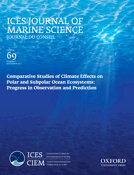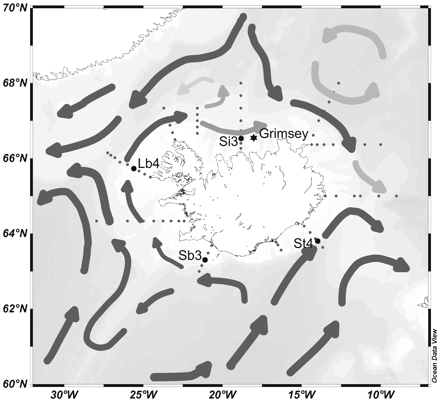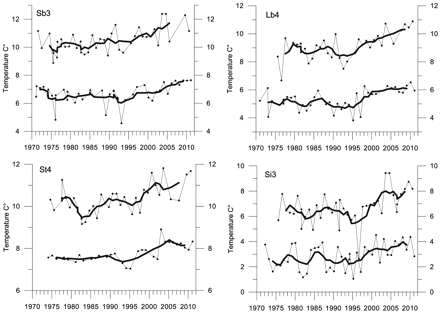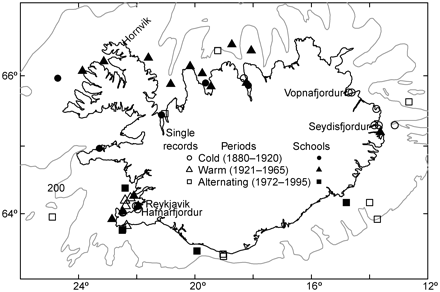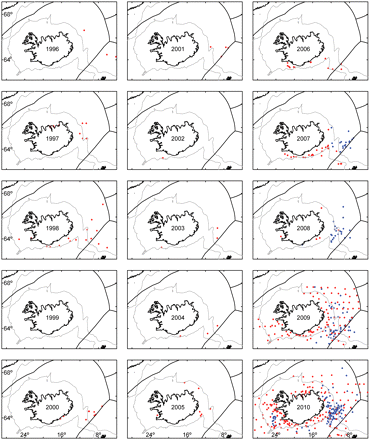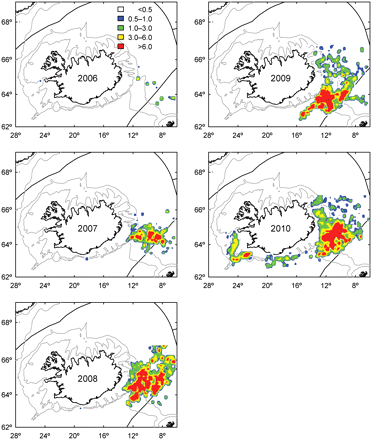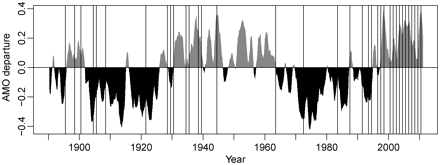-
PDF
- Split View
-
Views
-
Cite
Cite
Olafur S. Astthorsson, Héðinn Valdimarsson, Asta Gudmundsdottir, Guðmundur J. Óskarsson, Climate-related variations in the occurrence and distribution of mackerel (Scomber scombrus) in Icelandic waters, ICES Journal of Marine Science, Volume 69, Issue 7, September 2012, Pages 1289–1297, https://doi.org/10.1093/icesjms/fss084
Close - Share Icon Share
Abstract
Based on long-term investigations on sea temperature in Icelandic waters, five climatic periods are defined from the mid-1880s until today. These are a cold period between 1880 and 1920, a warm period between 1921 and 1964, a cold period between 1965 and 1971, one of intermediate conditions (alternating warm and cold) between 1972 and 1995, and finally a warm period from 1996 until today. Mackerel were first reported from Icelandic waters in 1895, were then found intermittently until 1996, and from then appeared almost every year and since 2007 in large numbers in many areas around Iceland. The occurrence of mackerel appears to be confined mainly to warm periods in the North Atlantic Ocean and around Iceland. The unprecedented occurrence and extended distribution of the species began at the onset of the recent warm period during the mid-1990s and, in recent years, 0-group and age 1 mackerel have also been observed in Icelandic waters. This expansion in distribution resulted initially in a bycatch fishery, which then developed into a direct fishery within the Icelandic Exclusive Economic Zone, increasing from ∼1700 t in 2006 to ∼120 000 t in 2009 and 2010.Astthorsson, O. S., Valdimarsson, H., Gudmundsdottir, A., and Óskarsson, G. J. 2012. Climate-related variations in the occurrence and distribution of mackerel (Scomber scombrus) in Icelandic waters. – ICES Journal of Marine Science, 69: .
Introduction
Atlantic mackerel (Scomber scombrus) are distributed widely on both sides of the North Atlantic. On the eastern side, their distribution extends from the coasts of Morocco in the south to northern Norway and also into the Black Sea, Mediterranean, Kattegat, Skagerrak, and the Baltic (Iversen, 2002, 2004; Jonsson and Palsson, 2006). In the Northwest Atlantic, the distribution extends from off North Carolina in the south to Labrador in the north (Sette, 1950; Parsons, 1970; Anderson and Paciorkowski, 1980). The Northeast Atlantic mackerel stock is considered to consist of three spawning units; south, west, and North Sea, of which the one in the west is currently the largest (ICES, 2011a). The spawning season for mackerel is from February to July, and after spawning, the south and west units migrate into the Norwegian Sea and North Sea to feed. Mackerel generally remain in the Norwegian Sea until August/September, after which they return south to their overwintering grounds in the North Sea, west of the British Isles, or in the Bay of Biscay (Iversen, 2004). In Icelandic waters mackerel have, until recently, only been observed sporadically and have therefore been considered to be vagrants in the area (Friðriksson, 1944; Jonsson, 1992; Jonsson and Palsson, 2006) and their increased presence during certain periods has been related to a warmer marine climate (Sæmundsson, 1934; Friðriksson, 1949; Astthorsson and Palsson, 2006; Palsson, 2006; Astthorsson, 2008; Astthorsson et al., 2010a, b). During the recent warm period in the North Atlantic (Hughes et al., 2010) and in the waters around Iceland (Valdimarsson et al., 2012), mackerel have migrated farther west and north in the eastern part (ICES, 2009). Therefore, the distribution and the abundance of mackerel in Icelandic waters have both gradually increased and, since ∼2007, they have been observed in the area in large numbers, which has led to an extensive fishery within Iceland's Exclusive Economic Zone, EEZ (ICES, 2011a).
Here, we summarize long-term variations in temperature in the waters around Iceland during the past 125 years, emphasizing the marked warming that has taken place since 1996. Also, available information on the occurrence and distribution of mackerel in Icelandic waters is compiled and summarized for the same period, and the observed changes are discussed in the context of decadal climate variations. The emphasis is particularly on the period since 1996, for which the most detailed information is available and during which the changes were most marked.
Data
The longest temperature time-series records available from Icelandic waters are surface measurements from the island of Grimsey off the north coast of Iceland (Figure 1). Recently Hanna et al. (2006) used the data from Grimsey and two other north coastal stations to construct a new 119-year (1883–2001) series of sea surface temperatures for the waters north of Iceland, known as NIce SST. This NIce SST series is used along with data from standard Icelandic hydrographic sections, occupied seasonally since 1970 (Malmberg and Valdimarsson, 2003; Valdimarsson and Jonsson, 2007) to describe the main features of the marine climate during past 125 years. This time-span also corresponds to records of mackerel observations in Icelandic waters. We present summer (August) and winter (February) observations from four different locations around Iceland (Figure 1) where temperature profiles have been averaged over a depth of 0–50 m.
Main surface currents in the waters around Iceland, and the location of standard hydrographic stations (dots). The four stations from which summer and winter time-series are presented are indicated (large dots: Sb3, Lb4, Si3, and St4). The star shows the position of the Grimsey SST station.
Information on the past occurrence of mackerel in Icelandic waters was compiled from various sources (mainly in Icelandic; see Astthorsson et al., 2010b, and references therein), sporadic commercial catches of mackerel brought to the Marine Research Institute (MRI) for investigation as rare fish, and more recently, samples collected during various research cruises by MRI research vessels and by the Icelandic pelagic fishing fleet. Further data were collected from RV “Arni Fridiksson” during summer ecosystem surveys of Icelandic waters and the Nordic seas (ICES, 2011b) and by RVs “Arni Fridriksson”, “Bjarni Sæmundsson”, and chartered trawlers during bottom-trawl surveys (see Palsson et al., 1989) of the Icelandic shelf in autumn 2010 and spring 2011. Finally, information is presented on the distribution of the recent fishery for mackerel by the Icelandic fleet within the Icelandic EEZ, based on vessel logbooks on positions and catch.
It is important to keep in mind that the old records of mackerel in Icelandic waters are not based on systematic scientific sampling, so they may provide a somewhat biased picture of mackerel occurrence and distribution in the area. Nevertheless, in the context of investigating the possible influence of climate on the long-term and large-scale distribution of the species, they are considered valuable and to reflect some of the actual changes having taken place.
Results and discussion
Climatic variations
Iceland is surrounded by three primary water masses (Atlantic Water originating in the south, and Polar and Arctic Water originating in the Arctic Ocean and Nordic Seas, respectively). A small branch of Atlantic Water flows north as the North Icelandic Irminger Current through Denmark Strait and then east along the northern shelf and shelf break, where it mixes in varying proportions with Arctic and Polar Water and run-off from the land. The core of the North Icelandic Irminger Current is often seen as a tongue of warmer, more-saline water as it flows to the east until it finally vanishes over the northeast part of the shelf (Stefansson, 1962; Malmberg and Valdimarsson, 2003; Jonsson and Valdimarsson, 2005; Valdimarsson et al., 2012). In the warm Atlantic Water to the south of Iceland, the marine environment is generally more stable, although marked changes in temperature and salinity have also been observed (Stefansson, 1999; Malmberg and Valdimarsson, 2003; Valdimarsson et al., 2012).
Temperature variations in the surface water north of Iceland during the period 1883–2001 are shown in Figure 2, and more-detailed observations in summer and winter in the upper 50 m during recent decades at four locations around Iceland in Figure 3. Figure 2 shows a relatively cold period towards the end of the 19th century. Then there was a rapid warming beginning around the 1920s, which was followed by a continued warm period until the early 1960s, with temperature peaks ∼1930 and 1960 (Hanna et al., 2006).
SST north of Iceland (Grimsey), modified after Hanna et al. (2006) by framing the main variations that have taken place during the period of observations (for location, see Figure 1).
Summer and winter temperature (mean 0–50 m) and 5-year running mean at four hydrographic stations southwest (Sb3), northwest (Lb4), north (Si3), and southeast (St4) of Iceland, 1970–2011 (for location, see Figure 1). Note the different scales on the y-axes.
Mid-1960s cooling started (Figure 2), and the period from 1965 to 1971 was characterized by low temperature and salinity and often accompanied by sea ice on the northern and eastern shelves (often referred to as the “ice years”). Between 1972 and 1995, “warm” and “cold” periods of 1–4 years alternated in the water north of Iceland (Figure 3, station Si3; Malmberg and Kristmannsson, 1992; Malmberg and Valdimarsson, 2003; Astthorsson et al., 2007). During the period 1996–1998, temperatures around Iceland began to increase steadily and that situation has continued until today around much of Iceland and in different seasons (Figure 3). In short, the observations since 1996 demonstrate an intensified flow of Atlantic Water towards Iceland and onto the northern shelf.
Summer temperatures at station Sb3 southwest of Iceland demonstrate maxima in the years 1972–1974, 1981, and 1984–1987, a slight increase in 1989, and then a more or less steady increase, particularly since 1996. The winter values also conform to this general pattern (Figure 3). Within the past 40 years, the highest summer and winter temperatures in the waters south and west of Iceland have been observed since 1998, right up to the present (Valdimarsson et al., 2012). A comparison of the temperature fluctuations in the warm water to the south of Iceland (Sb3, St4) with those in the cooler water off the west and north coast (Lb4, Si3) generally demonstrates that variations in the former area become evident 1–2 years later in the latter area (Figure 3). The same was noted by Belkin (2004), lending support to our decision to use the NIce SST as a basis for discussion of climatic variations over the wider area around Iceland. Further, Hanna et al., (2006) pointed out that the long-term variations in SST around Iceland broadly follow similar trends to those of the atmospheric temperature in the area.
Based on the description above, further published information (Stefansson, 1999), and other hydrographic monitoring transects around Iceland (Valdimarsson et al., 2012), the main features of the physical environment around Iceland can be summarized as follows: In Figure 2, these periods are shown as rectangles drawn onto the temperature time-series. The occurrence of mackerel in Icelandic waters is discussed below in relation to the temperature periods designated.
from ∼1880 to 1920, temperatures remained low while around 1920 they began to rise;
from 1921 to 1964, temperatures remained high, particularly so during the 1930s and 1940s, but then began to decrease during the early 1960s;
the period from 1965 to 1971 was characterized by limited inflow of Atlantic Water and low temperatures, and was often accompanied by sea ice on the northern shelf;
after 1972, temperatures increased again, but with alternating warm and cold periods of 1–4 year duration that continued until 1995;
in 1996, a warm period, which has lasted until today, began in the waters to the south and west of Iceland, and was followed after 1998 by the same in the north.
Mackerel occurrence
Available published records of mackerel in Icelandic waters between 1895 and 1995 are summarized in Figure 4.
Records of mackerel in Icelandic waters, 1895–1995. Open symbols show records of single fish and filled symbols show schools. Circles indicate records during the cold period of 1880–1920, triangles during the warm period 1921–1965, and squares during the alternating climate conditions 1972–1995. No mackerel were recorded in Icelandic waters during the cold period of 1966–1971.
1880–1920
Mackerel were first reported with certainty as a single fish from a southwest coast fjord (Hafnarfjordur) near Reykjavík in 1895 and during the same year as single fish from two fjords on the east coast (Seydisfjordur, Vopnafjordur; Sæmundsson, 1926). A still earlier, more-colourful record is from a chronicle entitled “A short report on Iceland's diverse nature” believed to be written between 1640 and 1644 by Jón Guðmundsson “the learned”, in which it was stated that mackerel had swam ashore in the Hornvik area (a cove on the northwest coast) one spring, to the extent that beaches and coves were covered (Hermannsson, 1924). Possibly this was the species today known as mackerel, but the occurrence on the beaches may also have been capelin (Mallotus villosus). The truth, however, is impossible to confirm. At the beginning of the 20th century, mackerel were further reported occasionally from around Iceland (Figure 4), usually only as single fish taken in gillnets in shallow water and in driftnets or purse-seines farther offshore (Sæmundsson, 1899, 1902, 1904, 1906). At that time, climatic conditions in the North Atlantic Ocean and around Iceland were generally cold (Figure 2). Therefore, it may seem somewhat surprising that most of these records of mackerel were from the colder waters of the north and northeast coasts, while there were none from the warm waters of the south coast proper (Figure 4). This picture may, however, be biased because there was no dedicated scientific effort then, and because of the nature of Icelandic fisheries taking place during the early part of the 20th century, with cod (Gadus morhua) and other demersal fisheries taking place during winter off the south coast, i.e. before mackerel would have arrived in Icelandic waters (if they arrived at all), and then the herring (Clupea harengus) fishery off the north and east coasts in late summer when mackerel may have arrived already. However, despite the limited records and the limitations which the distribution of the Icelandic fisheries may have imposed on actual observations of mackerel, we believe that during the cold years at the turn of the 20th century, mackerel were sporadic visitors to Icelandic waters.
1921–1965
During this period, a warm regime persisted in Icelandic waters, particularly so during the 1930s and 1940s (Figure 2). Marked changes which took place in the ecosystem around Iceland during the early part of the period have been reported by Sæmundsson (1934) and Friðriksson (1944) and discussed in a wider North Atlantic context by Drinkwater (2006). Among these changes was a more frequent appearance of mackerel and in schools when compared with previous records of mostly single fish (Sæmundsson, 1934, 1949; Friðriksson, 1944, 1949; Figure 4). The spatial distribution of mackerel observations around Iceland was similar to the preceding period, i.e. confined to the east, north, northwest, and southwest coasts, and again, somewhat surprisingly, there are no records from the warm Atlantic Water off the south coast proper. As pointed out above, however, this situation is most likely related to the type and seasonal distribution of the different fisheries conducted around Iceland at that time. It is also worth noting that during the latter part (ca. 1945–1964) of this long warm period, there is to our knowledge only one published record of mackerel in Icelandic waters (a single fish in January 1963; Jonsson, 1966). Possibly, this is because the Western stock of mackerel, the main component of the stock migrating into the Norwegian Sea and eventually into Icelandic waters, was at that time small. The fishery for that component was, however, limited at that time and little is known about actual stock size (Lockwood, 1978, 1988). Iversen (2004) mentioned that during the 1950s and 1960s, Norwegian herring boats sometimes came across mackerel in the Norwegian Sea in late summer on their return to Norway after fishing for herring on grounds near Iceland. However, the precise locations of those observations, and their regularity and quantity, were not mentioned.
1966–1971
During this cold period, there were no records of mackerel from Icelandic waters, and there is very little specific information on the distribution of the species in the waters east of Iceland and in the Norwegian Sea. Iversen (2004) pointed out that, before 1973, catches in the Norwegian Sea were usually small, i.e. in the range of up to 1000 t, which may reflect a limited distribution and small quantities of mackerel in the area then. As mentioned above, though, during the cold period at the turn of the 20th century, occasional records of mackerel in Icelandic waters do exist, but those were possibly partly related to a larger stock size and therefore a broader distribution then. However, no definite conclusions can be drawn based on such limited data. It is also worth bearing in mind that the early records of the 20th century cold period were mostly of single fish.
1972–1995
During this period of alternating warm and cold conditions, mackerel were recorded in 1973, 1983, 1987, 1991, 1993, and 1994 (Jonsson, 1992; Jonsson et al., 1992; MRI research database). Most of these records are again of single fish, and only in 1987 and 1991 were mackerel schools reported (Figure 4). During the later part of this period, the total stock size of mackerel was fairly stable at around 2.3 million tonnes (ICES, 2011a), so the records, although limited and mainly during warm years, may indicate the importance of temperature in determining the distribution and migration of the species. In warm years, a larger area of preferred temperature becomes available to the fish, perhaps leading to a broader distribution. During this period of alternating climate, almost all records of mackerel are from the waters off the south coast of Iceland, different from the situation during the previous periods (Figure 4). Many of the early records of mackerel in Icelandic waters were connected to the summer and autumn herring fishery off the north and northeast coasts, but as the 20th century passed, fishing activities with different types of gear became more or less continuous all around Iceland and in all seasons. Therefore, more records of mackerel off the south coast during summer and autumn are likely a reflection of this increasing and changing overall fishing behaviour.
1996–2010
Since 1996, the waters around Iceland have been relatively warm, yielding a temperature increase of ∼1–2°C in the upper 50 m off the south and west coasts of the country (Figure 3). Further, temperature increased off the north and northeast coasts, particularly in winter. Between 1996 and 1998, mackerel were caught at just a few stations east, northeast, and southeast of Iceland, usually as single fish (Figure 5). In 2000, they were recorded close to the coast and offshore off the east coast, and ∼220 t were taken as bycatch by the Icelandic pelagic fleet in the Norwegian spring-spawning herring fishery in the easternmost part of the Icelandic EEZ. From 2001 to 2006, there were reports of a few mackerel at several locations around the country, and a small but gradually increasing bycatch in the herring fishery was documented (∼20 and 1700 t in 2002 and 2006, respectively). Then, in summer 2007, there seems to have been a marked transition in the distribution and abundance of mackerel in Icelandic waters. The fish became more widely and uniformly distributed in the waters east of the country and westwards along the south coast. The situation was similar in 2008, but then in 2009 and 2010, an even broader distribution of mackerel was observed. By 2010, mackerel were distributed right round Iceland, although only to a limited extent off the northwestern corner (Figures 5 and 6).
Locations of mackerel catches from scientific surveys by the Marine Research Institute (red) and of mackerel samples taken by the Icelandic pelagic fishing fleet (blue), 1996–2010.
Mackerel catches by the Icelandic pelagic fleet, 2006–2010. The colour scale shows catch reflected tonnes per nautical mile2.
An extensive direct fishery for mackerel within the Icelandic EEZ has developed during the past four years, with catches increasing from 36 000 t in 2007 to >100 000 t in the years 2008–2010 (Anon., 2011). The fishing operations themselves involve extensive searching for the fish, so it may be assumed that the location of the mackerel fishery reflects the real distribution of the densest concentrations of the fish within the Icelandic EEZ. Research surveys similarly suggest an increase in mackerel abundance and distribution between 2006 and 2010. According to a swept-area analysis carried out as part of the International Ecosystem Survey in the Nordic Seas (IESNS) in July/August 2010, ∼1.1 million tonnes, or 23% of the mackerel biomass estimated by the survey, was within the Icelandic EEZ (ICES, 2011b). In recent years, therefore, a large part of the mackerel stock has extended its distribution by ∼400 miles west and 120 miles north, into Icelandic waters (Figures 5 and 6). Over the years too, considerable changes have been observed in the feeding migration of western mackerel (Iversen, 2002), but never before has such a westward and northward extension of that magnitude taken place. Overholtz et al. (2011) recently reported similar repositioning of the Northwest Atlantic mackerel stock as a result of temperature variability and gradual warming.
According to Iversen (2004), the Northeast Atlantic mackerel is found mostly near the surface at temperatures of around 8°C or higher during spring, summer, and autumn. In the waters around Iceland, the summer temperature in the upper 50 m to the southeast, southwest, and northwest has exceeded 8°C for the past 40 years. Off the north coast, though, it was not until 2003 and 2004 that summer temperatures as high as 8°C were observed (Figure 3). Further, although SST has been increasing steadily since 1996, there appears not to have been any abrupt change around 2007 that could possibly explain the sudden extension in distribution and increased abundance then. However, in addition to temperature, factors such as actual stock size and its age/size structure, feeding conditions, status of related stocks, and potential competition for food are all likely to affect observed distribution (Utne et al., 2012). The strong 2002 year class of mackerel was still abundant in 2007 (ICES, 2011a), and it constituted 27% of the catch within the Icelandic EEZ. As 5-year olds, this strong year class may have contributed to the extended summer migration north and west into Icelandic waters. Further, in the Norwegian Sea and in the waters east of Iceland, mackerel partly utilize the same feeding area as northern blue whiting (Micromesistius poutassou) and Norwegian spring-spawning herring. Loeng et al. (2009) pointed out that as pelagic fish biomass in the Norwegian Sea increased in recent years, zooplankton biomass decreased steadily, and suggested that the fish may be overgrazing the food resource. In the waters over and near the shelf east of Iceland, the zooplankton biomass is generally somewhat lower than in the adjacent Norwegian Sea (MRI, unpublished data). However, the zooplankton biomass has not decreased to the extent it has in the Norwegian Sea, so perhaps better feeding conditions around Iceland may have been partly responsible for inducing the westward and northward migration of mackerel into Icelandic waters. Results from mackerel egg surveys show that the spawning location of the species is shifting north, possibly related to increased SST (ICES, 2011c), another feature that might be influencing the changing distribution of the adult mackerel stock.
Generally, it is the largest mackerel that undertake the most extensive northward and westward summer feeding migration (Holst and Iversen, 1992), and the mackerel caught in the Icelandic commercial fishery and in the ICES IESNS during summer 2010 (ICES, 2011a) consisted of mature adults. However, during the groundfish survey in Icelandic waters in autumn 2010, 0-group mackerel (length range 19.0–22.0 cm) were observed over a wide area over the shelf to the southeast, south, southwest, and west of Iceland. Further, during the groundfish survey in the same area in spring 2011, 1-group mackerel were caught southeast and south of the country, which suggests that mackerel had remained through winter in the area. This unusual occurrence of 0- and 1-group mackerel in Icelandic waters is likely to be a consequence of the northward and westward expansion in spawning of the mackerel stock recorded during the international triennial egg survey (ICES, 2011c).
In addition to the major change in distribution and abundance of mackerel in Icelandic waters in recent years, many other temperate and boreal fish stocks, both exploited (e.g. haddock, Melanogrammus aeglefinus, and monkfish, Lophius piscatorius) and rare non-commercial ones (e.g. greater forkbeard, Phycis blennoides, and snake pipefish, Entelurus aequoreus) and vagrants (e.g. twaite shad, Allosa fallax, and garfish, Belone belone), have also been moved north and increased in biomass or abundance (Valdimarsson et al., 2005; Astthorsson et al., 2007; Astthorsson and Palsson, 2008). Further, many more-southern fish species (e.g. flounder, Platichthys flesus, sailfin dory, Zenopsis conchifera, and fourspot megrim, Lepidorhombus boscii) have also been reported from Icelandic waters during the recent warming (Astthorsson and Palsson, 2006; Valdimarsson et al., 2012). Higher temperature generally leads to a greater production at different levels in the Icelandic marine ecosystem (Astthorsson et al., 2007), and the broader geographic distribution of temperate and boreal species as demonstrated by these changes.
The marine climate around Iceland is under the influence of and affected by the larger scale climatic processes taking place in the northern North Atlantic, whereas local conditions affect smaller scales (Malmberg and Kristmannsson, 1992; Jonsson and Valdimarsson, 2005; Hátún et al., 2005). In view of the extensive geographic distribution of Northeast Atlantic mackerel (Iversen, 2004), its sensitivity to temperature changes (Murawski, 1993), and its marked changes in distribution and abundance in Icelandic waters, it was of interest to consider to what extent its presence in the area is associated with large spatial climatic or temperature variation such as the Atlantic Multidecadal Oscillation (AMO), which does affect the distribution and catches of pelagic fish (Alheit et al., 2009). Despite limited information during the early part of the period under consideration, Figure 7 shows that the historical occurrence of mackerel in Icelandic waters largely conforms to positive phases of the AMO and hence probably indicates that during warm periods, there is a general northward shift in the distribution of the main part of the mackerel population. During cold phases, however, there are records of mackerel in Icelandic waters during some years but such years are usually few and infrequent.
AMO (12-month running average, data from http://www.esrl.noaa.gov/psd/data/correlation/amon.us.long.data) with the years when mackerel were recorded in Icelandic waters superimposed as vertical lines.
Concluding remarks
The sudden and major change in the distribution of mackerel that took place during summer 2007 when the feeding distribution expanded west and mackerel were found in the Icelandic EEZ in large quantities seems to be unprecedented in terms of recent times. The underlying cause for the change is not clear, but is most likely the result of several contributing or co-occurring factors, such as a gradual increase in temperature, changes in the feeding conditions, competition with other major pelagic fish stocks in the area, and the relatively good status and age/size structure of the mackerel stock. The available data do not allow us to rank the relative importance of these factors in driving the change nor do we have knowledge of how a change like this is likely to affect the whole structure of the ecosystem in the region. That will remain the challenge for future studies, and it clearly calls for a continued coordinated summer survey in the Nordic Seas and perhaps an extension of the survey into adjacent waters farther south, so as to cover the whole potential distribution of the Northeast Atlantic mackerel stock simultaneously.
Acknowledgements
We thank two anonymous reviewers and guest editor Ken Drinkwater for helpful comments that improved the manuscript.
References
Author notes
Handling editor: Audrey Geffen


